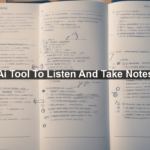Ever found yourself staring at a blank screen, struggling to pen down the perfect sentence? It’s a common challenge for writers, from novices to seasoned professionals. But what if an AI tool could write for you, seamlessly churning out content that mirrors your style and meets your needs? Welcome to the world of AI-driven writing tools, a groundbreaking advancement in artificial intelligence that’s transforming how we create content. In this post, we’ll dive into what these tools are, how they work, their benefits, and why they are becoming indispensable in the writing realm. Let’s unpack this fascinating topic!
What is an AI Writing Tool?
An AI writing tool is software powered by artificial intelligence that can generate written content based on given inputs. These tools use advanced algorithms and machine learning to understand context, grammar, and style, making them capable of producing human-like text. They can help with various writing tasks, from drafting emails and articles to creating social media posts and even writing full-length books.
How Does It Work?
The magic behind AI writing tools lies in sophisticated technologies such as Natural Language Processing (NLP) and Machine Learning (ML). NLP enables the tool to understand and generate human language, while ML helps it learn from vast amounts of data to improve over time. Tools like OpenAI’s GPT-3 are prime examples, exhibiting an uncanny ability to produce eerily human-like text.
Here’s a simplified process of how these tools function:
- You provide a prompt or specific input.
- The AI analyzes the input for context and intent.
- Using vast datasets and pre-existing knowledge, it generates content tailored to the prompt.
- Some tools even allow for post-generation editing to refine the output further.
Why Should You Use an AI Writing Tool?
AI writing tools are not just a novelty; they are massively beneficial in multiple ways:
Efficiency and Speed
These tools can drastically cut down the time you spend on writing. For instance, if you’re working on a tight deadline, an AI tool can generate a draft in minutes, freeing up more time for revisions and other tasks. This efficiency is particularly useful for content creators, marketers, and businesses aiming to publish frequent content.
Overcoming Writer’s Block
Writer’s block can be a creative nightmare. With an AI writing tool, you have a reliable partner to brainstorm ideas or even kickstart your writing process. Just input a rough idea, and let the AI provide a structured starting point.
Consistency and Quality
Maintaining a consistent writing style across different pieces of content can be challenging. AI tools ensure that your content remains coherent and high-quality, adhering to specified guidelines and formats. This can be particularly useful for content marketing strategies where a uniform tone is crucial.
Language and Grammar
Worried about grammatical errors? Advanced AI writing tools can also help in proofreading and editing content. They offer suggestions for improving readability, correcting grammar, and ensuring the text is polished and professional.
Are There Any Downsides?
While AI writing tools are revolutionary, they are not without limitations:
Lack of Creativity and Emotion
AI can mimic human writing, but it often lacks the nuance, emotion, and creative flair that only a human can provide. If your content relies heavily on emotional appeal, a human touch is still irreplaceable.
Ethical Concerns
There are ethical considerations to ponder. Using AI to generate content raises questions about the originality and authenticity of work. It’s crucial to use these tools responsibly and transparently, especially in academic and professional settings.
Popular AI Writing Tools
Curious about which AI writing tools to try? Here are some popular options that have garnered positive feedback:
- Grammarly: Primarily a grammar-checking tool, Grammarly’s latest features incorporate AI to suggest complete sentences and improve your writing.
- Jasper (formerly Jarvis): Known for its versatility, Jasper can generate blog posts, social media content, and even ad copy with impressive accuracy.
- Copy.ai: Specializes in marketing copy but is adaptable for various writing needs like email campaigns and product descriptions.
- Writesonic: Offers a range of templates and tools to create blogs, landing pages, and ads.
How to Choose the Right AI Writing Tool
With so many options available, how do you decide which tool is right for you? Consider these factors:
- Purpose: Identify your primary use case. Are you writing blogs, marketing copy, or technical documents?
- Features: Compare features like style customization, feedback options, and integration capabilities.
- Budget: Align your choice with your budget. Some tools offer free versions with basic features, while premium versions provide more advanced functionalities.
- User Experience: Look for intuitive and user-friendly interfaces to minimize the learning curve.
The Future of AI in Writing
The evolution of AI in writing is only just beginning. Future advancements may lead to even more sophisticated tools capable of human-like creativity and emotional depth. As AI continues to learn and improve, it will undoubtedly become an even more integral part of the writing process, enabling us to focus on what we do best – thinking creatively and pushing the boundaries of storytelling.
In conclusion, AI writing tools are more than just a passing trend. They are powerful allies in a writer’s toolkit, offering efficiency, consistency, and quality. As you explore these tools, remember to complement their capabilities with your unique voice and creativity. After all, the best content is born from the perfect blend of technology and human touch.











